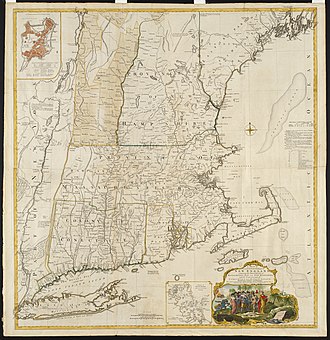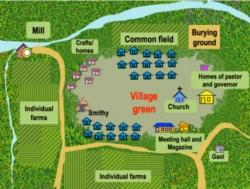Many genealogists in the United States find their searches leading them to the colonial days. Life in the North American colonies was not as dry, dull and boring as many might assume. The lives of all Americans today are still affected by the political controversies, shady business deals, royal intrigues and land grabs of the 17th and 18th centuries and much of this occurred in the New England Colonies.

The original New England colonies included the Province of New Hampshire,the Providence Plantations, the Colony of Rhode Island,the Connecticut Colony, the Massachusetts Bay Colony, the Plymouth Colony and the Popham company (a failed colony in what in now Maine.)
The Plymouth Colony was merged into the Massachusetts Bay Colony. The state of Maine was part of Massachusetts until 1820 and Vermont remained an independent state until it joined the union in 1791, becoming the fourteenth state of the United States. Maine became the twenty-third state in 1820.
Settlers for the early towns mostly emigrated together and shared common bonds such as religion. In fact, the first colony in New England was Plymouth Colony, established in 1620 by the Puritans who were victims of religious persecution in England. Many of the other early settlements were started for the same reason.
Research your ancestors on MyHeritage
Establishing the settlementEstablishing the settlement

The New England colonies grew through a process of group settlement. The courts of the colonies would negotiate terms with a group who wanted to settle in the area. Then, a grant of land would be assigned to the group for a new town and boundaries established by the courts or legislature. It was then decided who were to be settlers and who to be freeholders; what was common land; how farms were apportioned and grazing practices.
The townspeople would determine the location of village green,church and minister's home (always near the center of the town). and how individual parcels of land would be marked off facing the green. Common duties such as militia obligations and street repair were assigned and town law established.
The settlers lived within the boundaries of the town for safety's sake and would travel to and from town to their farms each day. Plots within the town were alloted to families for small (usually one room to start) homes. Single men and women were expected to work out a living arrangement with one of the families and were not encouraged to build homes of their own.
One of the very first buildings to be completed would be the meeting hall or town hall. The open town meeting would include all who wanted to take part though only those who met certain criteria were allowed to vote. Voting rights were usually extended to male property owners who were church members in good standing and at least 24 years old. These requirements were determined primarily by each town and were gradually eased over the years.
The settlement would be enclosed within high walls for increased safety against attack and ammunition centrally located in a magazine. Other features of the early towns would be a designated burial ground, a grist mill, a smithy, a home for the leader of the settlement and perhaps a gaol (jail) for those who broke the rules. When population increased, the physical arrangement of the town often did not allow for easy expansion. Therefore, the town might be split into two or more communities, each to continue independently of the others. Eventually, larger towns and cities were established as industries such as ship building, whaling and sea commerce began to grow.
Land tenureLand tenure
The collective nature of early New England colonies led to several systems of land tenure,if not ownership. The open field system stressed the communal nature of all property.This approach did not work well and did not survive long. When more people settled in the area, common areas were being abused and overused. People would plant crops and fail to tend them. Fences would not be repaired and animals wandered from one farm to another. Other problems mounted and tensions grew.
Land records from the first permanent settlements in America date back to 1620. Over the next fifty or sixty years settlers began to question the right of colonial governors to require quit rents[1] for the use of land and started to press for individual ownership and property rights.[2]
The original charters did not address the issue of buying or otherwise acquiring land from indigenous populations (also known as confiscating land). As a result, land rights of these groups were often ignored though there were those who did act in good faith. It had become common for companies to purchase land from local tribes. Sometimes the land was "sold" by tribes to several companies or individuals. Fraudulent claims to land titles became common until finally forbidden by the British Government in 1763.[1] [2][3]
Some colonists simply took illegal possession on land that was claimed by other colonists. Still others just found land that appeared to be unclaimed and proceeded to settle there. This often caused conflict about who had the right to own which piece of land. Land ownership could not be proved legally without registration of descriptions of individual plots. The problem continued to grow until 1787 when the newly formed United States made its first attempt to establish land ownership laws.[3]
Explore more about the New England coloniesExplore more about the New England colonies
- Massachusetts Land Records at the University of Massachusetts Amherst
- Connecticut Land Records on the Connecticut's Official State Website
- New Hampshire Land Records - Find public record resources and free search tools
- New Hampshire Public Recordson the Public Records Online Directory
- Rhode Island Land Records - The State of Rhode Island the Land Records page
- Maine Land Records on the Maine County Commissioners Association
- Vermont Digital Records on the
References
- ↑ Beverley W. Bond, Jr., Vol. 17, No. 3 (Apr., 1912), pp. 496-516 (21 pages) https://doi.org/10.2307/1834386. open access.
- ↑ Ely, James W., 'The Origins of Property Rights: The Colonial Period', The Guardian of Every Other Right: A Constitutional History of Property Rights, 3rd edn, Bicentennial Essays on the Bill of Rights (2007; online edn, Oxford Academic, 22 Mar. 2012), https://doi.org/10.1093/acprof:oso/9780195323337.003.0002, accessed 10 Feb. 2024.
- ↑ https://vgtitle.com/creation-land-title-system-america/

